Column: Let’s do away with insurance networks. They’re not lowering healthcare costs
This column is about the need for the U.S. healthcare system to pay more attention to mental health — a need that’s been made painfully clear by rising rates of depression, substance abuse and suicide during the COVID-19 pandemic.
But it’s also about coverage networks in general and the absurdly high cost of out-of-network care, which can run significantly more than the exact same in-network treatment and result in surprise medical bills.
“The recent trend has been toward smaller ‘narrow networks’ with relatively few providers,” said James Bailey, a healthcare economist at Providence College.
This is “good for insurers and a mixed bag for patients,” he told me.
I’ve been stewing on this since speaking the other day with Gary Smith, who has been grappling with depression for years, since before the coronavirus upended all our lives. The last 12 months have only added to his difficulties.
Among other things, the Sherman Oaks resident has dealt with the COVID death of his 78-year-old father. He’s faced his dog succumbing to cancer.
“I don’t want to make it sound like it’s been worse for me than anyone else,” Smith, 53, told me. “But it’s been tough.”
I asked him to elaborate. The pain was evident in his voice.
“The isolation,” Smith said. “The not knowing if I would get sick. The not knowing if it was safe to go to the grocery store. Trying to hide things from others on Zoom.”
None of this is unique to him. I’d wager we’ve all confronted similar feelings over the last year.
The pandemic cracked the unspoken agreement between many employers and their workers to keep personal issues away from the job. Will change follow?
But when you’re facing such challenges while also trying to control the intense, often debilitating feelings of anxiety and despair that can accompany clinical depression — that’s a whole other order of magnitude.
Smith scoured the coverage network of his insurer, Blue Shield of California, but was unable to find a suitable therapist. Most in-network therapists, he said, either aren’t taking new patients or don’t provide the specific form of trauma therapy he requires.
Making matters worse, Smith said, Blue Shield raised his deductible for out-of-network care to $1,000 from $500 last year and limited the amount that could be applied to the deductible.
He said he’s spent about $2,400 seeing an out-of-network therapist in recent months. Blue Shield, he said, has reimbursed him less than $300.
“What they’re basically doing is making mental health unaffordable,” Smith said.
Mark Seelig, a Blue Shield of California spokesman, declined to discuss particulars of Smith’s situation.
He said only that the company “takes mental healthcare, especially during the pandemic, very seriously,” and has expanded online and telehealth resources for people seeking assistance.
We frequently stigmatize mental health and treat such problems as being unusual or uncommon. That’s just foolish.
The coronavirus pandemic, wintertime, the daily stressors of life — it all can take a toll on our mental health. Here are some resources to help you understand therapy, how to find a therapist and more.
According to the National Alliance on Mental Illness, more than 50 million U.S. adults experience some form of mental illness. That’s 1 in 5.
Nearly 8 million young people ages 6 to 17 experience such disorders. That’s 1 in 6.
Suicide is the second-leading cause of death among people ages 10 to 34, after unintentional injury.
All these statistics predate the pandemic. Jutta Joormann, a psychology professor at Yale University, told me things are even worse now.
“The impact [of the pandemic] is high,” she said. “The question is who will recover easily when this is over and who won’t.”
Treatment by skilled professionals, needless to say, can help. If you can get it.
The advent of coverage networks dates from the 1970s, when hospital costs rose sharply. Insurers responded in part with health maintenance organizations, or HMOs, that restricted patient choice but kept premiums affordable.
They also dumped more costs onto patients in the form of co-pays and deductibles, and created the networks that limited the doctors and facilities a patient could visit.
These networks were seen at first as a shrewd way of addressing costs. Insurers could deliver a higher volume of patients to in-network providers and thus gain more leverage in price negotiations. In theory, savings would be passed along to policyholders in the form of lower premiums.
Things didn’t play out in patients’ favor. Insurers got their bargaining power. Medical providers got their higher volumes. And patients watched as their healthcare choices narrowed and their costs kept going up.
Spending on healthcare totaled about $74 billion in 1970, according to the Kaiser Family Foundation. By 2000, medical costs hit roughly $1.4 trillion. In 2019, the total more than doubled to $3.8 trillion.
On a per-person basis, annual healthcare spending has soared from an average of $353 in 1970 ($1,848 in inflation-adjusted dollars) to $11,582 in 2019.
From 2010 to 2020, family insurance premiums climbed by 55% and deductibles jumped by 111%. Inflation over the same period rose by just 19%.
Put it all together and it’s painfully clear the healthcare industry is raking in gobs of cash, while patients are stuck with increasingly higher costs and limited choices.
A single-payer, “Medicare for all” system would fix this — as we can see in almost all other developed countries that have affordably achieved universal coverage by adopting such approaches.
A single-payer healthcare system once again is being talked about for California — the leading candidate for governor supports the idea — and once again the issue is being framed as a debate between starry-eyed dreamers and sober-minded realists.
Barring that, we could make significant progress in leveling the playing field by simply doing away with coverage networks.
“If we did away with networks, insurance companies would essentially be offering identical coverage to all patients in a geographic area and competition among insurance plans may increase,” said Aparna Soni, an assistant professor of public administration and policy at American University.
“Insurance companies may be forced to lower premiums in order to attract consumers,” she told me.
Without networks to keep prices in check, Soni warned, some medical providers might try to aggressively raise prices. But I think that could be managed.
Price controls would be one solution. Or we could adjust co-pays using a sliding scale, with the patient’s out-of-pocket cost rising in tandem with a higher charge for treatment.
Untethered by a coverage network, a patient would be free to take his or her business to a more affordable provider — the way a truly competitive marketplace is supposed to work.
Networks are just another way the healthcare industry masks costs and maximizes profit. And if that means people like Smith have fewer treatment choices, well, there it is. This system wasn’t designed for his benefit (or yours).
If you find that depressing, you’re not alone.
More to Read
Inside the business of entertainment
The Wide Shot brings you news, analysis and insights on everything from streaming wars to production — and what it all means for the future.
You may occasionally receive promotional content from the Los Angeles Times.













